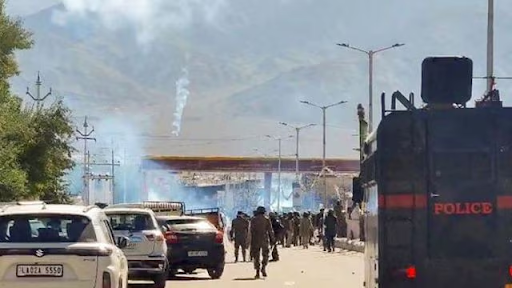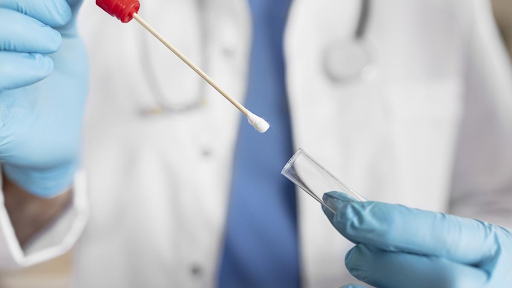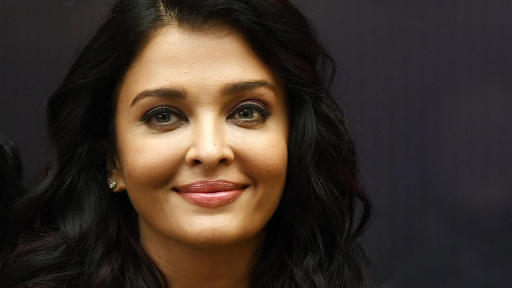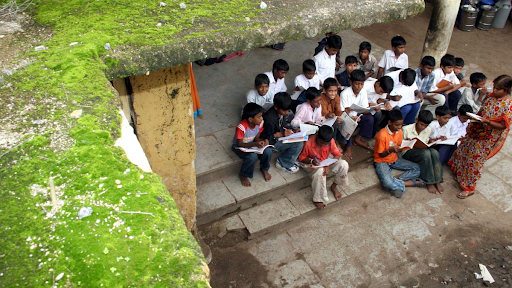Description
_Programme_Inauguration.jpg)
Disclaimer: Copyright infringement not intended.
Context:
- Union Minister for Youth Affairs and Sports, Shri Anurag Singh Thakur, inaugurated the Khelo India Rising Talent Identification (KIRTI) program in Chandigarh.
Khelo India Rising Talent Identification (KIRTI) program
- KIRTI aims to identify and nurture talent among school children aged nine to 18.
- The nationwide scheme will have two main objectives: to hunt talent from every nook and corner of the country and to use sports as a tool to curb addiction towards drugs and other gadgetry distractions.
- The nationwide programme, inaugurated across 50 centers, targets 50,000 applicants in its initial phase, focusing on 10 sports, including athletics, boxing, wrestling, hockey, football, and wrestling.
- KIRTI aims to conduct 20 lakh assessments across the country throughout the year to identify talent through notified Talent Assessment Centres.
- It aligns with the vision of Prime Minister Shri Narendra Modi to bolster a sports culture and secure global medals for India.
- Shri Thakur emphasized early engagement in sports, aiming to make India a top 10 sports nation by 2036 and a top five by 2047.
Implementation and Methodology:
- KIRTI utilizes transparent selection methods based on Information Technology and Artificial Intelligence for talent identification.
- Collaboration with National Sports Federations and state governments is essential for the program's success.
- Over Rs. 3000 Crore has been allocated for infrastructure, with 1000+ Khelo India Centres established nationwide.

Future Prospects:
- India aspires to host the Youth Olympics in 2030 and the Summer Olympics in 2036.
- KIRTI is poised to strengthen India's soft power through sports and aligns with the government's focus on ease of business.
ABOUT KHELO INDIA MISSION
- The Khelo India Scheme is the flagship Central Sector Scheme of the Ministry of Youth Affairs & Sports.
- A brainchild of Prime Minister Shri Narendra Modi in 2017-18, the Khelo India Mission aims at infusing sports culture and achieving sporting excellence in the country thus allowing the populace to harness the power of sports through its cross-cutting influence.
- Under the “Sports Competitions and Talent Development” vertical of the Khelo India Scheme, the “Talent Identification and Development” component is dedicated to working towards the identification and development of athletes at the grassroots and elite levels to develop the sports ecosystem in the country.
Reorganized Components
- The Khelo India Programme, previously divided into 12 verticals, has been restructured to enhance efficiency and effectiveness.
1.Creation and Upgradation of Sports Infrastructure:
- Focuses on developing and improving sports facilities across the nation.
2.Sports Competitions and Talent Development:
- Includes annual sports competitions and talent search initiatives like the Khelo India Winter Games.
3.Khelo India Centres and Sports Academies:
- Supports state-level Khelo India Centres and various sports academies for talent grooming.
4.Fit India Movement:
- Introduces the Fit India Movement as a dedicated component to promote physical fitness.
5.Promotion of Inclusiveness through Sports:
- Emphasizes promoting sports among women, people with disabilities, and rural communities.
- The reorganization aims to streamline operations by merging similar components into larger ones.
- This consolidation condenses the previous 12 components into five, facilitating better coordination and resource allocation.
Issues plaguing the Sports Sector in India
- Financial constraints:The Indian government spends far less on international athletic events than China, the US, and other nations, with more significant results. This forces athletes to make private purchases for high-quality equipment, training, and travel, which puts disadvantaged people at a significant disadvantage due to the shortage of sports funding.
- Lack of Resources:The nation lacks a sufficient amount of high-caliber athletic infrastructure. The government has built several excellent stadiums in metropolitan areas, but the situation is dire in rural areas.
- Attitudinal Roadblocks:Sports are not seen as a viable professional path in our nation. Parents urge their kids to pursue careers in engineering and medicine rather than sports. The proverb “Kheloge Kudoge hoge kharab; Padhoge Likhoge hoge nawab” reflect this. This indicates that whereas academics will give you a life fit for a king, athletics will ruin yours.
- Governance Problems:Multiple problems affect sports administration. For example, male athletes and metropolitan areas get far more sports funding than female athletes and rural places. Allegations of prejudice and nepotism in the selection process, particularly against lower castes, have been made.
- Religious Restrictions:Several activities, such as swimming and athletics, demand clothing that does not entirely conceal a woman’s body, which is against the rules of some faiths.
- Lack of Sports Culture:People do not actively support and enjoy sports in India. However, cricket receives the most excitement, which helps it draw investment and pay its players well.
- High-Performance Pressure:A sportsperson is under a lot of stress to win a medal or be ready to lead a vulnerable existence. Sometimes, this puts individuals under too much mental strain or encourages them to use immoral tactics like doping.
- Cricket Dominance: Cricket's immense popularity in India often overshadows other sports. The Indian Premier League (IPL) and international cricket events receive substantial media coverage and sponsorships, leading to cricket players becoming household names. This cricket-centric focus diverts attention and resources away from other sports.
- Lack of Infrastructure and Investment: Many sports in India suffer from inadequate infrastructure, training facilities, and investment. Government support and funding are disproportionately allocated to cricket, leaving other sports underfunded and struggling to develop talent. This lack of resources hinders athletes' progress and success in international competitions.
- Limited Media Coverage: The media plays a significant role in shaping public perception. While cricket receives extensive coverage, other sports often receive minimal airtime and newspaper space. This lack of exposure makes it challenging for non-cricket athletes to gain recognition and sponsorship deals.
- Governmental Policies: Lack of prioritization: Historically, sports have not been accorded high priority in governmental policies, resulting in limited funding and support. Bureaucratic hurdles: Red tape and bureaucratic processes often delay or obstruct the implementation of sports-related initiatives. Inconsistent policies: Changes in government leadership lead to shifts in sports policies, resulting in inconsistency and discontinuity in long-term planning

Steps taken in the sports sector in India:
- Sports Code Implementation: The Sports Code, formulated by the Ministry of Youth Affairs and Sports, aims to ensure transparency and accountability in sports governance. It mandates sports organizations to adhere to certain guidelines regarding governance, elections, and transparency in their operations.
- Sports Talent Identification Portal (STIP): Launched by the Ministry of Youth Affairs and Sports, STIP is an online platform designed to identify and nurture sporting talent across India. It allows athletes to register and showcase their skills, facilitating their selection for various training programs and competitions.
- Mission Olympic Cell (MOC): As part of the TOPS initiative, the Mission Olympic Cell was established to identify and support potential medal prospects for the Olympics. It provides athletes with financial assistance for training, coaching, equipment, and participation in international competitions.
- Khelo India Youth Games: Khelo India Youth Games is an annual multi-sport event organized by the Ministry of Youth Affairs and Sports to promote grassroots-level sports talent. It provides a platform for young athletes to showcase their skills and compete at the national level.
- National Centre of Excellence (NCOEs): The government has identified and established NCOEs across India to provide world-class training facilities and coaching to elite athletes. These centers focus on specific sports disciplines and aim to groom athletes for international success.
- Fit India Movement: Launched by Prime Minister Narendra Modi, the Fit India Movement aims to promote physical activity and sports participation among all age groups. It encourages people to adopt a healthy lifestyle through regular exercise and sports activities.
- Corporate Sponsorships and Partnerships: Private sector companies have increasingly been involved in sponsoring athletes, supporting sports events, and investing in sports infrastructure. This includes partnerships with sports federations, sponsorship of athletes, and funding for sports development programs.
- National Sports Federations (NSFs) Reforms: Efforts have been made to reform and streamline the functioning of NSFs to improve their governance and efficiency. This includes adherence to the Sports Code, conducting transparent elections, and enhancing accountability in their operations.
- Sports Science and Medicine Support: The government has focused on providing sports science and medicine support to athletes through specialized institutions and programs. This includes sports science research, sports medicine clinics, and sports injury rehabilitation facilities.
- International Training and Exposure: Athletes are provided with opportunities for international training and exposure through collaborations with foreign sports federations, training camps, and participation in international competitions. This helps athletes gain valuable experience and exposure to international standards.
Way Ahead
- Holistic Development Programs: Implement comprehensive sports development programs that cater to all age groups and regions, focusing on talent identification, training, and competition at grassroots, junior, and elite levels.
- Investment in Infrastructure: Continue to invest in the development and maintenance of sports infrastructure across the country, with a focus on creating world-class training facilities, stadiums, and sports academies in both urban and rural areas.
- Promotion of Sports Culture: Launch nationwide campaigns to promote a culture of sports and physical activity, emphasizing the importance of sports for health, well-being, and national pride.
- Inclusion and Diversity: Ensure inclusivity and diversity in sports by providing equal opportunities for athletes from all backgrounds, genders, and abilities. Promote underrepresented sports and provide support for para-athletes to excel on the international stage.
- Public-Private Partnerships: Foster collaboration between the government, private sector, and civil society organizations to leverage resources, expertise, and networks for the development of sports infrastructure, talent identification, and promotion of sports culture.
- Sports Education: Integrate sports education into school curriculums and promote the importance of sports as part of holistic education. Provide training and certification programs for coaches, sports administrators, and sports science professionals to enhance the quality of sports training and management.
- Governance Reforms: Continue to implement reforms in sports governance to ensure transparency, accountability, and professionalism in sports organizations and federations. Strengthen regulatory mechanisms to prevent corruption, doping, and other malpractices in sports.
- International Collaboration: Strengthen international collaborations and partnerships with other countries, sports federations, and international organizations to exchange knowledge, best practices, and expertise in sports development, training, and competition.
- Technology and Innovation: Embrace technology and innovation in sports training, performance analysis, and sports medicine to enhance athlete development, injury prevention, and performance optimization.
- Long-term Planning and Monitoring: Develop and implement long-term strategic plans for sports development with clear goals, targets, and performance indicators. Establish mechanisms for regular monitoring and evaluation to track progress, identify challenges, and adjust strategies as needed.
Conclusion
- India needs a more balanced approach to sports development. This includes diversifying sports investments, enhancing infrastructure, promoting grassroots sports, and changing societal perceptions about sports careers.
- While cricket will likely continue to dominate Indian sports, a concerted effort to support and recognize athletes in other sports can lead to a more inclusive and successful sporting landscape.
- The government, media, and the public need to recognize the potential and talent that exists beyond the cricket pitch, empowering Indian sports players to excel on the global stage.
MUST READ ARTICLES: https://www.iasgyan.in/daily-current-affairs/sports-governance-in-india
https://www.iasgyan.in/daily-current-affairs/governance-of-sports-in-india
|
PRACTICE QUESTION
Q. Examine the hurdles hindering the growth of sports in India, considering governmental policies, infrastructure, and societal perceptions. Suggest feasible reforms to enhance India's global sporting presence, emphasizing inclusivity and sustainability. Support your analysis with pertinent examples.
|




_Programme_Inauguration.jpg)
_Programme_Inauguration.jpg)





